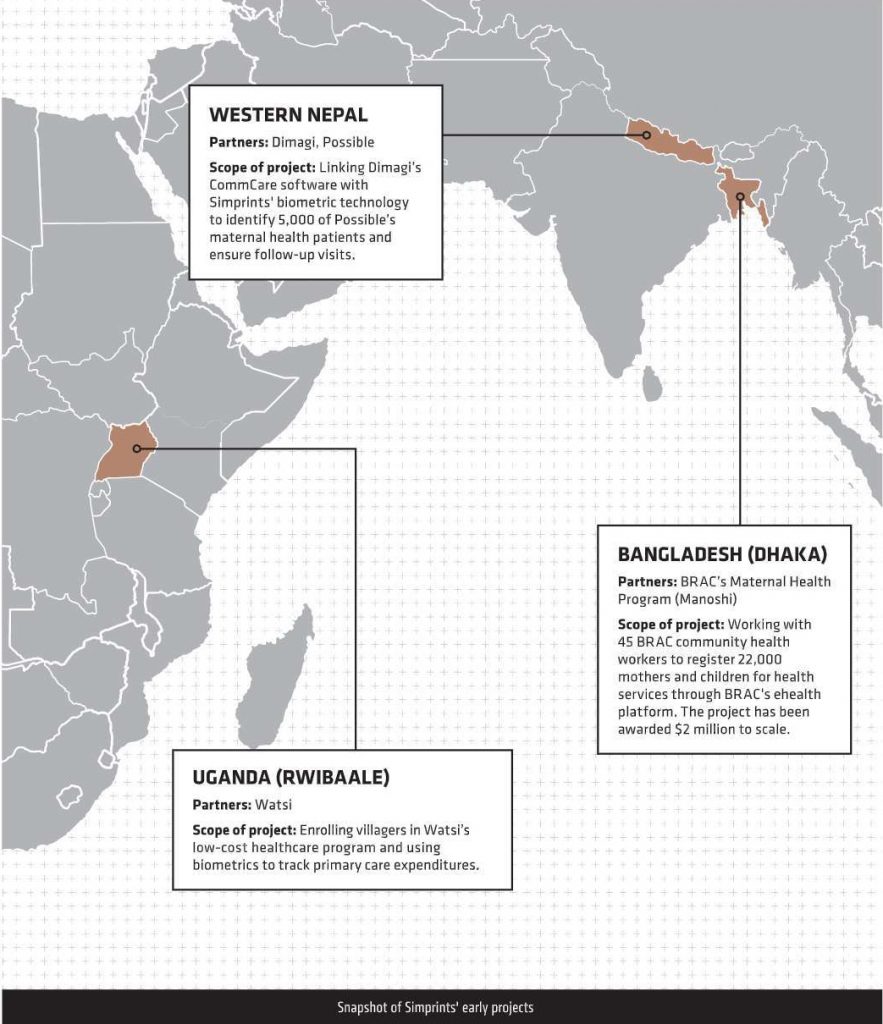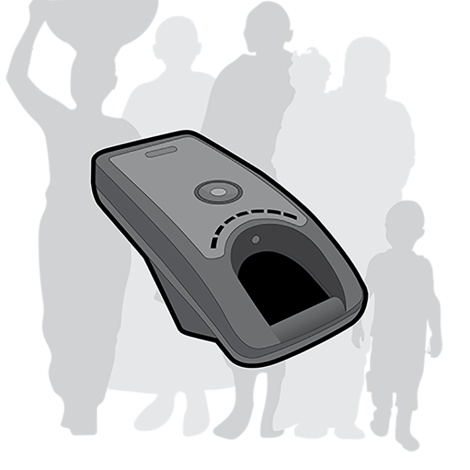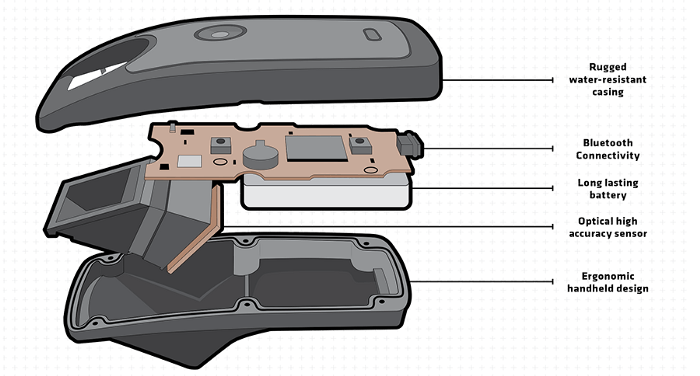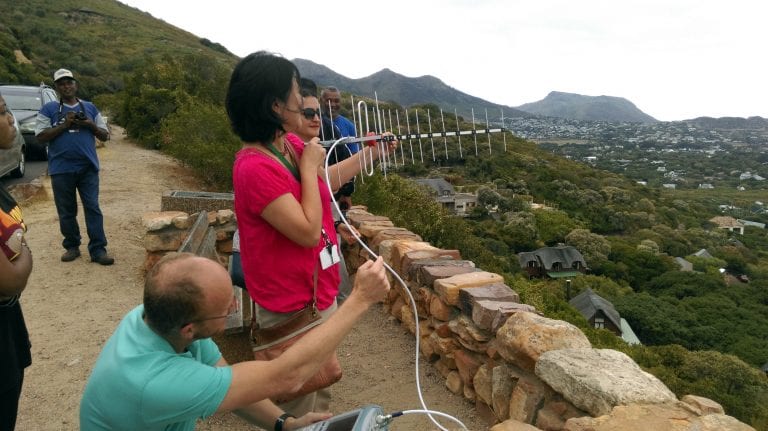Editor’s note: The U.K. biometrics startup Simprints is developing ways of identifying the hundreds of millions of people whose births have never been officially registered. Here we offer an updated case study that was first published in Demand magazine in Spring 2018.
Demand: ASME Global Development Review shuttered after six years of publishing in-depth coverage of the most interesting manifestations of design, engineering and social ventures in global development. The biannual magazine was a premier source of global development writing and a sister publication to Engineering for Change. As an homage to Demand and the work of the experts whose voices it disseminated, we are reprinting the magazine’s articles on this site.
 In August 2016, 19 frontline workers at a hospital in the Himalayas of Western Nepal told Sebastian Manhart a grim story of mistaken identity. Manhart was leading a training on how to use a handheld fingerprint scanner to help the workers speed up and improve patient service. When he asked them what value they felt the scanner could bring to their work, Manhart says they told him a story that was “quite shocking.”
In August 2016, 19 frontline workers at a hospital in the Himalayas of Western Nepal told Sebastian Manhart a grim story of mistaken identity. Manhart was leading a training on how to use a handheld fingerprint scanner to help the workers speed up and improve patient service. When he asked them what value they felt the scanner could bring to their work, Manhart says they told him a story that was “quite shocking.”
The hospital serves a constellation of tiny, remote villages interspersed throughout the region’s steep slopes. These frontline workers trek for 10 to 12 hours along Himalayan footpaths to reach their patients, who might not ever see a clinic or trained medical personnel otherwise.
One of the workers had diagnosed a village resident with HIV, and told the patient to travel to the hospital to collect medication for treatment. “Somebody showed up at the hospital and that person, unfortunately, had the same name as the patient in the village,” Manhart says.
The hospital staff supplied HIV medication to the person who arrived and who then returned home. Then, the thing happened that may be inevitable in small towns worldwide: People began to talk. The stigma historically associated with HIV thrives in rural Nepal, and the person who was taking the HIV medication was expelled from the community.
“Six months later, when it was basically too late, this frontline worker realized that the wrong person with the same name had been given the medication,” Manhart continues. “So, the person with HIV was never treated, and the person without HIV was treated and stigmatized and excluded from their community.”
Those are the kinds of devastating life-altering mistakes that Simprints, where Manhart serves as chief operating officer, is working to avoid. Based in Cambridge, in the United Kingdom, Simprints has developed a patented, low-cost, low-fuss fingerprint scanner for the company’s biometric data collection and transmission service. Since launching in 2014, Simprints has attracted high-powered partners, including mobile chip and software company ARM and international development giant BRAC. In 2018, the company was awarded a $2 million innovation prize from the Saving Lives at Birth competition.
Following receipt of the award, Simprints tripled its employee base and built its capability to identify and document millions of underserved people from Bangladesh to sub-Saharan Africa. Even in the midst of explosive growth, the startup’s leadership recognizes potential hurdles in their path. A high one may be technological competition. A boom in mobile phone-based biometric scanners may render Simprints’ own fingerprint scanner obsolete. But the Simprints team appears oddly sanguine about that possibility. An obstacle of greater concern may be privacy and public perception. The company is treading carefully through the minefield of ethical questions and potential security risks that come with handling personal data, while trying to serve the world’s most economically vulnerable.
Documenting the undocumented
In advanced economies, identity starts — officially — with the birth certificate. States create records of newborns and often issue an identification number that follows a person for life. Sometimes they stamp a document with tiny footprints. It’s an unceremonious, bureaucratic process that most take for granted.
That inauspicious start underpins a lifetime of identification paraphernalia: permits, licenses, badges, cards, passports. Official identity rides with us in billfolds. It opens doors, both figurative and literal. It is easily proven, sometimes harder to hide than some would prefer, and its loss can be catastrophic.
Not so in some of the world’s poor and remote communities. Only 71 percent of the global population has a registered birth, the U.N. estimates. As expected, those who do are distributed unevenly. In sub-Saharan Africa, for instance, only 46 percent of children under the age of five have a registered birth.
While the thought of having no identity may not occur to many people in developed countries (and may even sound utopian to those concerned about privacy in today’s hyper-connected world) the reality is bleak.
“Just simply knowing that somebody has been born is critically important for planning secondary or primary education, for planning vaccination programs,” and other services, says Ken Banks. Banks founded the Kiwanja Foundation, a non-profit that promotes mobile technology for social advancement, and he created FrontlineSMS, an open source mobile data collection and dissemination platform used in global development work. He is also a member of Simprints’ advisory board.
“When families need to think about social care or other kind of support that you might give them, if there’s no record that [their] child exists, it’s very difficult on the financial side to get any sense of how they’re trying to support themselves. It’s pretty fundamental and something that we take for granted in the developed world,” Banks says.
In response, the U.N. added the need for an official identity to its Sustainable Development Goals, calling for universal birth registration by the year 2030 as “a first step towards safeguarding individual rights and providing every person with access to justice and social services.”
Not a hardware enterprise
The fingerprint scanner at work in Western Nepal is Simprints’ flagship device. Simprints does not call itself a hardware company, however. In spite of its award-winning technology, Simprints leadership swears it is an information service. It provides identity documentation and verification methods to non-profits, governments and others working to deliver services around the world.
In fact, hardware had little to do with the organization at the start, and its fingerprint scanner may be incidental to its business model.
“They initially felt that they could just buy something off the shelf and put together the right software and the right sort of business processes around it,” says Dominic Vergine, head of sustainability and corporate responsibility at ARM, the Cambridge-based multinational semiconductor and software firm whose chips can be found in 95 percent of mobile phones. ARM has worked with Simprints since it was conceived at a health hackathon that ARM supported in 2012 at the Centre for Global Equality, also in Cambridge.
“They then discovered that they couldn’t buy something suitable off the shelf, so they were sort of forced into developing this new product. But it wasn’t what they set out to do. They did it out of necessity,” Vergine says.
That perspective helps explain the Simprints team’s apparent indifference to competition from hardware manufacturers. Manhart says that if mobile fingerprint, iris or any other biometric scanners become commonplace, and if they outperform Simprints’ device, then Simprints will simply adopt them into its toolkit.
A rugged fingerprint scanner
For now, however, Simprints’ fingerprint scanner may be in a class of its own. The device, called Vero, is thus far unique in the field of biometric devices. It is designed for the unusually austere conditions found in the world’s remote and underserved communities.
“The scanner needs to be rugged. Not just airport security rugged — sub-Saharan Africa rugged. It needs to be dust proof, water resistant, lightweight, long battery life, and easy to use,” says Tristam Norman, who co-founded Simprints’ and serves as its chief technology officer.
The scanner weighs 105 grams and is 108mm by 46mm by 41mm — roughly the size of a feature phone. Drop tests find the scanner is shock resistant up to 1.2 meters onto concrete. It can operate in temperatures ranging from freezing to 45°C, at up to 90 percent humidity. It can withstand storage temperatures of -20°C to 60°C. It has an IP rating of 65, signifying complete protection from dust, and resistance to low-pressure water jets from any direction. Tests found no water damage after spraying the device with a hose from three meters away at a pressure of 30 kilopascals.
The scanner runs on a 1050 mAH lithium ion battery that burns out in 4.5 hours under heavy usage (4,000 scans) or 14 hours under lighter usage (200 scans). It charges with a standard micro-USB, which, if lost or damaged, is now relatively easy to find anywhere.
Those are some of the attributes that set Simprints’ scanner apart from other products on the market. Compared to the increasingly common fingerprint scanners on mobile phones, Simprints’ device is well suited for rugged conditions and can read and analyze fingerprints that are wet, worn, calloused or scarred.
“Most biometric devices are made by 30-year-old engineers, with the hands of 30-year-old engineers,” Norman says. “When you try to scan the fingers of someone who has been a manual laborer for the last 30 years [that kind of device] doesn’t hold up as well.”
Simprints’ scanner takes 300- by 400-pixel images at a resolution of 500 DPI. The data it produces conform to specifications for biometric data interchange formats by the International Standards Organization and the U.S. National Institute of Standards and Technology. Vero’s data is also certified by the U.S. Federal Bureau of Investigation.
Vero securely transmits fingerprints and analysis via Bluetooth to mobile devices using Android operating systems. The scanner is compatible with several mobile data gathering platforms that healthcare workers, governments, and global development practitioners use, including CommCare, Open Data Kit, and District Health Information System 2.
Foremost, Simprints’ Vero is easy to use and mistake-resistant. “We can’t make the user experience too technical, because this may be the first time a health worker interacts with a smart phone and scanner ever,” Norman says.
Navigating security and privacy
Biometric data collection is on the rise, with governments and private enterprises around the world already amassing stores of biometric data on citizens and customers. India made biometric identification mandatory, fingerprinting and scanning the irises of nine out of 10 of its 1.3 billion citizens. The U.S. is building what may be the world’s largest database of face-recognition data. (Both initiatives have been the subject of public controversy.) Canadian banks are testing a bracelet that verifies account holders according to their unique heartbeat. Smartphones track fingerprints, faces and even so-called “behavioral biometrics,” such as subtle movements made while typing on virtual screens.
In short, biometric identification is increasingly infiltrating daily life worldwide, and its use cases are growing, from voter registration to banking. Indeed, the technology market intelligence firm Tractica predicts growth in global biometrics revenue from nearly $3 billion in 2015 to more than $15 billion in 2024. However, as identification methods shift from numbers and passwords to the human body, the onus of biometric data and privacy protection still falls primarily on the entities that gather the data, including Simprints.
As a precaution against identity theft or nefarious use of personal data, Simprints runs every new potential project by its pro bono legal team in London. “They flag any potential abuses they see. If they think that the project has too much potential to be used for malicious purposes, we won’t go ahead,” Norman says.
Once a project is underway, Simprints has three key technical measures in place for safeguarding its data. The first happens inside its scanner.
“The fingerprint image itself never leaves the scanner. All preprocessing happens inside the scanner itself,” Norman explains. “It’s impossible, currently, to reverse engineer a fingerprint image from an extracted template.”
The second is in how data is transferred between Vero and other mobile devices. Vero’s mobile connection uses Advanced Encryption Standard (AES) encryption. The data inside the phone also uses AES encryption, and while it is online to the servers, it uses an encryption certificate linking a browser and the server as well.
Finally, for the data that Simprints stores, the organization adheres to the European Union’s Safe Harbour guidelines — “arguably the strictest in the world,” Norman says. The Safe Harbour Privacy Principles were developed to reduce the risk of the disclosure or loss of personal information stored by private organizations in the E.U.
While data security is a priority, it is worth noting that the fear of identity theft is only an issue for who those already have documented identities. For someone who doesn’t, the risks are intangible, or at best, inconsequential. Banks notes that this is often forgotten by development workers, mostly from affluent countries, working on global identity challenges.
“They see it as, well you know, [the people they’re serving are] going to have to give their data up, and it might not be great, but they have a choice,” Banks says. “Well, often, they don’t really have a choice. It’s all or nothing for them.”
Building a foundation
Simprints has seen eye-popping growth in the three years since its official launch in 2014. ARM has nurtured the company from the start, including subsidizing fees at a makerspace while the Simprints team was working on the prototype of its scanner.
“Several ARM engineers spent their spare time to help Simprints get up to speed in electronics design, which was new to them. So, we’ve been involved in helping create the environment where something like Simprints can happen,” ARM’s Vergine says.
In the year of its launch, Simprints won a seed grant from Saving Lives at Birth, which is a collaboration between U.S., U.K., Canadian and Norwegian government aid agencies and the Gates Foundation. (ARM offered a partial match of the grant, and the company has also provided letters to other global competitions stating a commitment to match money that Simprints may win. Vergine says he does not know whether that would have affected Simprints’ early success on the competition circuit.) With the grant money, Simprints forged partnerships with BRAC, headquartered in Bangladesh, and the Johns Hopkins Global mHealth Initiative, to launch a pilot study testing Simprints’ technology with health workers in Gaibandha, Bangladesh.
Simprints’ first year closed after hundreds of hours of field tests and three redesigns of the prototype. In its second year, 2015, the organization won a grant from Innovate U.K. that funded software development and supported pre-production of the fingerprint scanner. The company unveiled the scanner in its current iteration in 2016.
In 2017, Simprints won a $2 million Saving Lives at Birth “transition to scale” grant. The money will fund work with BRAC to deliver maternal healthcare to nearly 4.5 million pregnant women and their children in Bangladesh.
At the time of writing, Simprints is involved in seven projects in Nepal, Bangladesh, Afghanistan, Uganda, Nigeria, Zambia and Kenya. Ten more are on the docket for 2018, Manhart says.
New challenges
In parallel to its maternal health program, Simprints has also won additional grants from Innovate U.K. and Saving Lives at Birth to fund the development of technology that can read and process infants’ biometric data. The technical challenge in analyzing an infant’s fingerprints is predicting how the prints will change as the baby grows. The Simprints team is using machine learning on a dataset of neonatal prints that may be able to track a baby’s prints into adulthood.
“We have made a compelling case that we can address this problem and provide reliable identification for neonates that will be a game changer in terms of civil registration, vaccine delivery, and every service you could provide a baby,” Manhart says.
Simprints is also applying part of its funding to a second research project: hardware-less biometrics.
“We are doing R&D into seeing if the scanner itself can be replaced with a simple add-on, or even by just the camera of an Android device,” explains Norman.
These new initiatives may be a big part of Simprints’ future, but its existing capabilities are more than sufficiently in demand. Manhart recalls that shortly after launching Simprints’ website, the organization had 200 requests from organizations around the world.
“Impact organizations that tell us they need us to do this yesterday,” he says, adding, “There’s a huge mismatch between demand and supply. And that mismatch is costing lives. So, we have huge pressure to increase our bandwidth as soon as possible.”
Amid that pressure, Manhart frequently comes back to his conversation with the healthcare workers in Nepal about how Simprints could help them prevent medical mix-ups and deliver better care.
“It was something that really drove home why we’re doing this, and that this is costing lives every day. On many levels,” he says. “And it’s something that’s 100 percent preventable. That’s why we’re in this and this is what keeps me getting up.”
Simprints has changed in the three years since the publication of this article. Sarah Grieves, Partnerships Manager for the company, shares milestones.
2018
A longitudinal study of a biometric-enabled community health program in impoverished urban neighborhoods in Bangladesh provides evidence for the efficacy of the technology. A study of 1600 women found that biometrics uniquely identified mothers during perinatal period and resulted in 38 percent more visits, 27.64 percent increase in patients with comprehensive birth plans, 14 percent more women daved money for birth and 19 percent more newborns received all essential care.
2019
- Simprints establishes its Bangladesh and Ethiopia offices
- Simprints partners with Gavi and NEC to develop a toddler biometrics solution
- Simprints begins work developing its first contactless biometrics solution
2020
- Simprints hits a “1,000,000 beneficiaries reached” milestone
- Winner of the MIT Solve ‘Health Security and Pandemics’ Challenge for “Biometrics for Vaccines Delivery”, to identify patients, track their vaccination records, and ensure verified delivery of vaccines
- Winner of two awards from the Financial Times & the International Finance Corporation: the ‘Health, Wellness, and Disease Prevention’ Award and the ‘Excellence in Disruptive Technologies’ Award for Simprints’ biometric ID technology for impact verification in global health and development
- Top 10 in the UK’s Best Small Workplaces in Tech, and Top 25 in the UK’s Best Small Workplaces
2021
- Simprints has been deployed in 14 different countries around the world.


